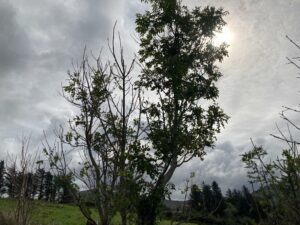Ash dieback continues to devastate Irish tree population
Rapidly spreading disease has ‘grave implications for biodiversity and landscape
Ash dieback disease was first identified in the Republic in late 2012, in Co Leitrim, among a consignment of ash trees imported from Europe.
John Gaffey, a horticulturist based in Carrick-on-Shannon, was quick to spot the speed with which ash trees throughout the county started to die once the fungal parasite arrived in 2012.
“Before it arrived every roadside was full of ash trees,” he said. Gaffey, from Mohill, said that traditionally farmers when cutting back hedgerows always left a few ash trees intact, but a year after dieback struck he could already see the devastation being caused.
The disease has spread so much that driving the Leitrim roads is “like driving through an ash tree graveyard”, he said.
It has since been discovered in every county in Ireland and has the potential to kill up to 90 per cent of existing ash trees, research from the State agriculture development authority shows.
Ash dieback is a highly destructive fungal disease that causes leaf loss and canopy decline. A small proportion of ash trees may have a genetic tolerance to ash dieback, meaning they will survive.
Teagasc is planning to establish a gene bank of ash tolerant to the disease with the aim of planting stock for forests and hedgerows in the future.
But for landowners and farmers who have been encouraged to plant woodlands, the disease is nothing short of a disaster with costs estimated in the region of €800 million. The figure is made up of lost income but includes costs of up to €7,000 per hectare to remove diseased trees.
Ash is a hardwood but grows significantly faster than oak or beech and is used widely in sawmills as well as being the traditional source of hurleys. The trees are ubiquitous in hedgerows along many smaller roads. Removing fallen trees is likely to be another significant cost.
The Government has spent almost €10 million on two schemes launched in 2013 and 2020 to help land owners who have planted trees. These are an enhanced site clearance grant rate, and enhanced grant rates for replanting.
The Irish Farmers’ Association has called for compensation for those affected by the scheme.
Minister for Agriculture Charlie McConalogue has ruled out compensation for loss of landowner’s crops. He said State aid rules were “explicit that this aid is for restoration and does not facilitate compensation for loss, including income”.
In July Mr McConalogue told the Dáil the exact origin of ash dieback disease in Ireland, or when it was introduced, is unknown. But he confirmed “the first finding of the disease was found “on October 12th, 2012 in Co Leitrim”. He said it would not be appropriate to name the importer or the distributors as they had not done “anything illegal”.
In June Minister of State at the Department of Agriculture Pippa Hackett announced that an independent review group is reviewing the existing ash dieback support scheme.
Teagasc says that ash dieback, which is caused by the fungal pathogen Hymenoscyphus fraxineus, will have grave implications not just for timber production but for amenity, biodiversity, carbon sequestration, landscape and culture.
Ash dieback is also largely responsible for the shortfall in reaching the 30 per cent annual broadleaved planting target. The target is a requirement under the department’s State aid approval of the Forestry Programme and forms part of Ireland’s National Biodiversity Strategy under the Convention on Biodiversity to which Ireland and the EU are parties.
Full article at Ash dieback continues to devastate Irish tree population – The Irish Times
For more information contact us at www.forestryservices.ie


